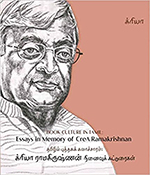The basic problem is that we do not have a book culture in Tamil Nadu. Many may not agree with this view. They will quote the number of books published each year and the publishers to counter this view. But, the concept of the medium called ‘book’, its role in epistemology, and the attendant aspects connected with it right now, are not sufficient to create and support a book culture. The only way forward is for the small publishers to keep labouring consistently.
–Ramakrishnan, S., Nedumpayanam, 2021: pp. 24 -25
S Ramakrishnan (1944–2020) wrote thus in an article presented at a seminar held by the National Book Trust in 1977. He had just founded a small publishing house called CreA in 1974 along with his partner and colleague V. Jayalakshmi (1930–1987). From 1974 to 2020 till he passed on, Ramakrishnan lived his dream of creating a book culture by small publishers. The volume at hand is a document honouring his memory by recording the various modes by which he created this book culture, so much so his name became synonymous with CreA.
The articles are classified under the following heads: Dictionary, Editing, Design, Language of Literature and Translation. All the above-mentioned disciplines have shaped the book culture that Ramakrishnan dreamt of. Fourteen scholars from all over the world have dealt with these aspects in this volume. E Annamalai, C T Indra, Christina Muru and T Sriraman have together edited this volume. The articles critically engage with how these areas help create book culture and the contribution of CreA Ramakrishnan in spearheading the same. Most of these articles also document Ramakrishnan’s perspectives on these aspects and how the scholars interpret his works. The volume has been produced bilingually. While the articles are in the language submitted by the authors, an abstract in English/Tamil as the case may be, is provided for readers to follow the thread of thought. The Bio-notes of the contributors are also given bilingually.
Gregory James, the author of Colporul: A History of Tamil Dictionaries (CreA: 2000) has addressed the contemporary relevance of the CreA dictionary. He raises the nagging question as to why we should publish dictionaries in print in this techno-era given to computerization in which proof reading, syntax, diction, synonyms, usage, translation and the word-sense correlation are possible. He arrives at the conclusion that we need the dictionaries in print based on various illustrations from CreA dictionary. He explains how new words are created in each language based on contexts. And how the printed dictionary enhances our understanding of the material we get from online sources.
PR Subramanian uses the metaphor of ‘having a delicious feast’ to describe the use of a dictionary. It contains the cultural aspects of a linguistic group; it documents the multiple aspects of a culture. He assesses the distinctive features of the CreA dictionary in comparison with the other dictionaries available in Tamil. For example, he lists words like Thirunangai, Thirunambi, Thirnar that have been included in the third edition of the CreA dictionary (p. 97). It explains how the dictionaries keep changing and growing.

